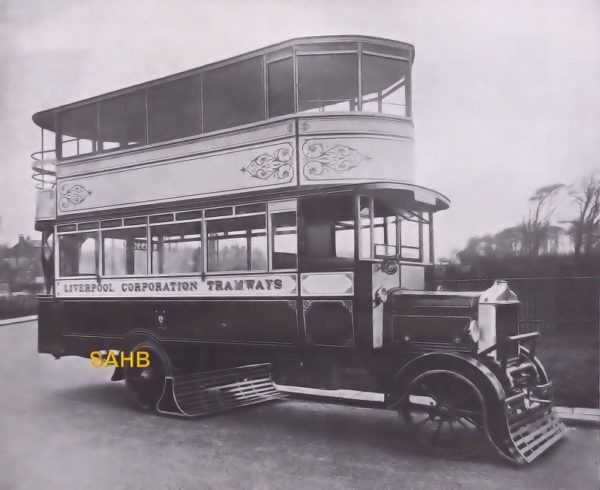
In February 1920 at least two important commercial trade journals announced the introduction of a new omnibus for the Liverpool Corporation. It was based on an AEC (Associated Equipment Company) chassis and powered by a 4-cylinder 7.7-litre 45-hp Tylor engine. Neither the chassis nor the engine was of particular note – but other features were.
Firstly, the bus was big – with a passenger capacity of 55. The old standard London omnibus (a design influenced by horse buses, with the driver behind the engine) had a capacity of 34, and AEC’s London General Omnibus Company K-type gained 12 seats by having an engine alongside the driver – but this bus for Liverpool had yet another 9 seats.
Equally important was the protection of upper-deck passengers from “inclement weather”. The deck was roofed in and provided with glass windows that could be opened sufficiently to provide good ventilation. For the first time also, the driver was completely protected from the weather, and there was even room for an additional three passengers alongside the driver.
But perhaps the most remarkable feature was the addition of patented front and rear “wheel lifeguards” designed by a Mr. Mallins. They were carried on forwardly-projecting brackets mounted on the axles, thus eliminating the height variations which occurred when guards were fitted to the frame of the chassis. A fixed clearance was given between the road and the lower edges of the guards but that could be adjusted for tyre wear – a significant issue in those days of solid rubber tyres. The wheels were said to be protected “at any angle”: clearly visible in our Snapshot are the side valances on front and rear wheels.
One reporter worried about the effect of greater capacity on the ease of picking up and dropping off passengers – a single staircase was always a bottleneck. However, he immediately dismissed this thought with a rather London-based comment: “Perhaps this loss of time does not matter so much in Liverpool where the traffic congestion is nothing like so great as it is in the centre of London.”
The provision of effective lifeguards was still a problem five years later, when Commercial Motor explained that tramcars dropped a scoop-type guard when triggered by a body touching a swinging plate at the front – but that the wheels on a bus were too far forward to allow the time for such a triggered guard to drop. Why the guards seen in our Snapshot five years earlier had not been introduced more widely remains a mystery – as does the prevalence of unwary pedestrians walking in front of trams and buses. Even in 1925 it would seem that the general public were still not aware of the far greater danger of powered transport against that of the horse-drawn vehicles to which they were accustomed.
Photo courtesy of The Richard Roberts Archive: www.richardrobertsarchive.org.uk







Leave a Comment